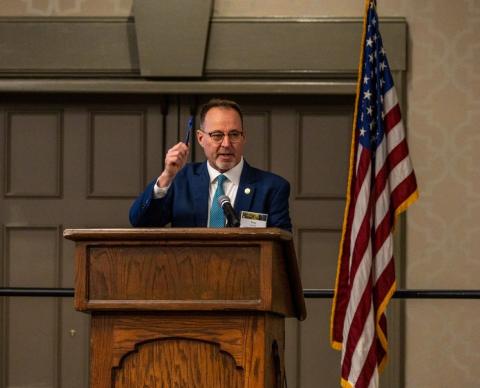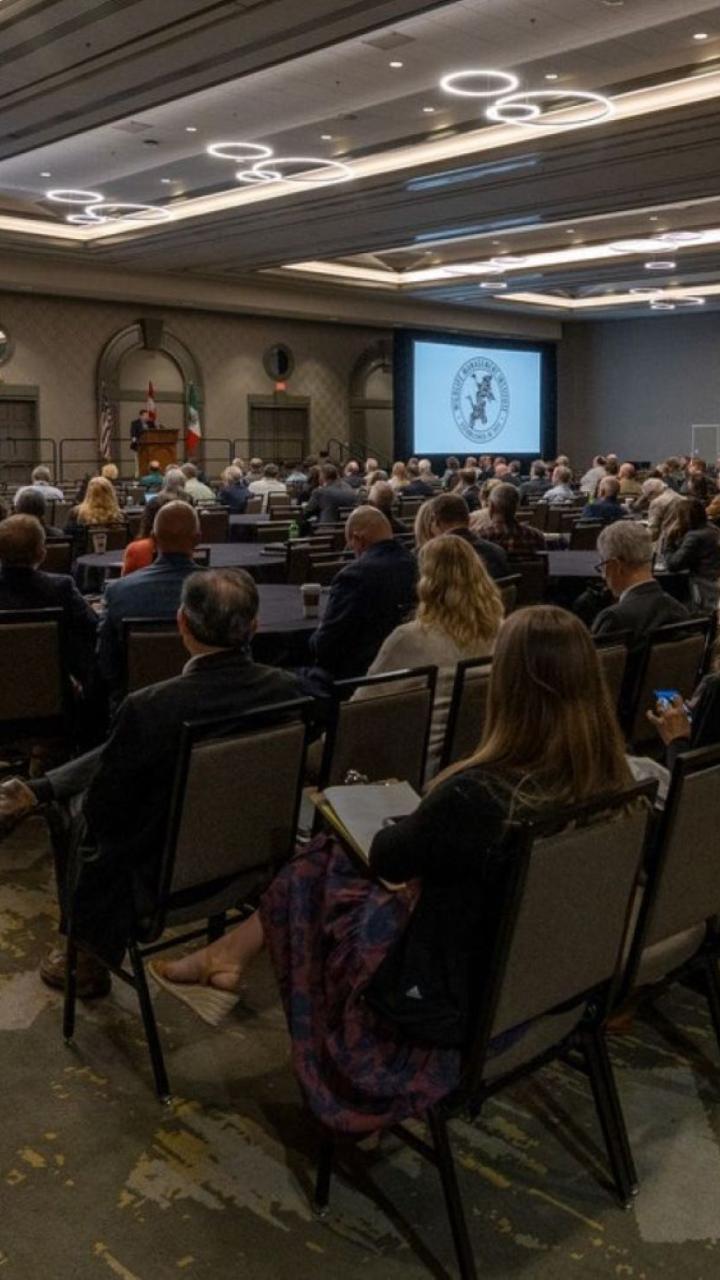Breadcrumb
- Home
- Outdoor News Bulletin
- April 2025
- Foundational Elements of Wildlife Conservation
Outdoor News Bulletin
Foundational Elements of Wildlife Conservation: Toward a Broader Vision
Foundational Elements of Wildlife Conservation: Toward a Broader Vision was the title of the plenary at the recently held 90th annual North American Wildlife and Natural Resources Conference in Louisville, KY. But what does that mean, a “foundational element,” and why now?? “Foundational elements” refer to the basis or groundwork on which something rests or is built according to Dictionary.com.
Why now?

Previous efforts to provide such elements include the American Game Policy of 1930, the North American Wildlife Policy of 1973, and the North American Model of Wildlife Conservation in 1992. Each of these past efforts were reflections of the existing condition of North American natural resources and the social context as well as existing and anticipated needs. Since the writing of the North American Wildlife Policy in 1973 over 50 years ago, there has been continued and significant change in the human population size, level of resource use, scientific understanding, societal attitudes, technology, natural resource abundance, and social discourse.
Additionally, in the time since the 1973 writing, there have been numerous significant developments and advancements in conservation knowledge and approach, efforts for example include: Wildlife Governance Principles, the Relevancy Roadmap, One Health, collaborative processes, human dimensions, and landscape scale approaches just to name a few. Although valuable conservation touchstones, their creations have been scattered through time and their presence is scattered across the literature, both of which hinder broader awareness of their existence, their application, and their incorporation into contemporary conservation governance.
WMI asserts that today is an appropriate time to develop a process to more clearly identify and articulate foundational elements of North American conservation, that can provide a basis for evaluating increasingly complex natural resource proposals and ultimately affect the security of our future and the quality of our lives.
Perhaps more insight on the question of “why now?” can be gained by exploring where we are in conservation today and how it was that we got here. This might also help to explain why so many people perceive this need now and sense the urgency and ripeness of the moment for something more.
Young Science Born from a Need
Conservation as a western “Science,” didn’t really begin until the mid-1800s. Of course, there were beliefs and ideologies common throughout indigenous cultures that were consistent with conservation philosophies and beliefs of today, but conservation as an accepted and accredited interdisciplinary science really began out of the necessity to address species and systems whose conservation needs arose due to colonial man’s impacts on the environment. Conservation emerged because of the era of overexploitation.
Conservation is truly an interdisciplinary “practice,” involving many much older academic disciplines like chemistry, biology, and physics, for example. As science history goes, conservation is an incredibly young science and it underscores the need for us to recognize it truly is a “practice,” and that conservation science is not quite yet fully baked.
As with all sciences, we must continue to refine our practice of conservation science, through an ever learning and iterative process . We do that every day in our lives with so many other things and just like, as with those many other things, on occasion, we need to pause, reflect, and refocus.
Conservation Eras
Although my focus on the last 150 years coincides with the time frame during which European man’s impacts most required appropriate conservation responses and actions, I’m often reminded of indigenous insights by simple statements and expressions offered by various tribal members. In a recent conversation regarding the significance and importance of forest health and upper watershed condition to the fish residing in the drainages below them, a Nez Perce elder casually responded with amusement at having to hold a debate about this relationship between forest and fish and dismissively stated, “of course, everyone knows that fish grow on trees.” Now of course he meant it figuratively and not literally, but for him, it was a foregone conclusion, this was a plain and simple fact, perhaps a foundational element of his conservation paradigm, and certainly not an issue worthy of debate—fish and forest health are inseparably linked, one and the same. This knowledge and concept was likely the basis or groundwork upon which that tribe’s forest health practices were built.
As we pause and reflect over the past 150 years, the concept of distinct conservation eras can be a useful aid. We can imagine the distinct eras as defined by the attitudes, opinions, and conditions within each era. It’s the attitudes, opinions, and conditions along with the policy bursts that define each of five distinct conservation eras.
The period leading up to 1850 was simply the era of abundance, followed in 1850 by the era of overexploitation, 1900 began the era of protection, 1930 the era of management, and finally, in around 1970 the era of environmentalism commenced. In each of these five distinct eras, there existed unique attitudes and opinions that defined the conditions of the day and because of the unique attitudes and opinions, there were unique products of policy and process generated within each era.
During the era of overexploitation is when the Boone and Crockett Club was formed in 1887, bringing a focus on fair chase hunting and initiating sportsmen-led wildlife conservation. The era of protection began in 1900 with the passage of the Lacey Act followed by the Migratory Bird Treaty Act. 1930 began the era of game management with the 1930 American Game Policy, wildlife management curriculum, the creation of the duck stamp, cooperative research unit establishment, The Wildlife Society, Ducks Unlimited, National Wildlife Federation, and the passage of the Pittman-Robertson Act. What a history rich era for conservation. 1970 was the beginning of the environmental era and represents a significant policy pulse that includes among other things, the creation of the EPA, ESA, NEPA, Clean Air Act, Clean Water Act, and more.
The last significant pulse of national conservation policy in the US occurred in the late 1960s and early 1970s. Looking at these distinct eras helps to demonstrate why we so often use the punctuated equilibrium model to describe conservation’s historical highlights as they occur in pulses and are separated by long periods of stasis like the one we find ourselves in now. Also relevant is the chaos of the day that catalyzed these events.
Where from Here?
What IS our next era? Why have we not seen policy bursts or the creation of organizations, events, funding, or legislation signifying the conditions, attitudes, and opinions of our time? How truly unique is this moment, in which we can take this opportunity to write the very history that we are a part of, rather than to simply live it, letting it happen to us, and have it only to be told to our children and children’s children solely from a retrospective view. How unique an opportunity is it to write our own history as opposed to having it written for us and by someone other than us?
As we look back at modern conservation’s relatively short history, it isn’t difficult to find elements that are foundational to our work. There is legislation that is foundational to our work like the Lacey Act and the Migratory Bird Treaty Act. There are philosophies and paradigms that are foundational to our work; like the Fair Chase Ethic, Theodore Roosevelt’s “Conservation as a National Duty” speech, and of course the Leopold Land Ethic. There are foundational elements of conservation like public trust, allocation by law, and democracy, emphasized in the North American Model of Wildlife Conservation.
However, it’s clear we need more. More to reflect on, more to add, and more to build. Not only, have we at times forgotten, or ignored, those who came before us, in many instances, we fail to heed their guidance, their suggestions, and their recommendations. The dismissal of past wisdom simply because it’s not “new’ and “fresh” is an underappreciated problem. Most scientists know that often the research and information you trust the LEAST, is that which is the most recent. The most reliable data are those that have stood the test of time and been confirmed by subsequent scientists. We need this wisdom as the bedrock of our foundation not the rubble we remove to make room for “fresh perspective” alone. We need to reinvest in the old and also invite and embrace the new. As we develop new tools, new science, new approaches, we need new ways to memorialize new items into our practice of conservation. We need to identify new and emerging foundational elements of successful conservation, elements like collaboration, partnership, landscape scale, corridors/connectivity, and integration.
Pressure on wildlife and wildlife habitat have grown exponentially since the writing of 1973 North American Wildlife Policy. The planet’s population has more than doubled since 1973. Societal attitudes have changed, and agencies are increasingly challenged on both the technical level of governance and the values that have shaped current agency policy and culture. In the face of these changes, WMI is convening a renewal of the foundational elements of conservation upon which public trust trustees and managers can base governance. WMI is designing and implementing a broadly engaging process to systematically examine and modernize the foundational elements of wildlife management and provide guidance for forward looking and durable governance.
Reflection, Refinement, and Reaffirmation
Ultimately, the nature of the challenge before us is to define our future through the compilation of existing foundational elements, through the distillation of relevant and meaningful elements scattered in time and space, the curation of foundational elements from our past successes, and the creation of new elements from our current knowledge and practice. All to craft a broader conservation vision for a better conservation future.
All science is refined through time with input from researchers and practitioners alike. Refining is an iterative process and conservation is no different. It is time for us to take inventory of the great works that laid conservation's bedrock, integrate our existing innovative and emerging approaches, and look to the future.
We need to recognize this Foundational Element effort is a passion driven pursuit and we will make some mistakes and may need to pivot. One thing for certain though, conservation will come out of this better than when it went into it.
This effort is a reinvestment in conservation’s foundational elements not a reinvention. It represents an innovative integration of historic doctrines with modern and emerging approaches to create a broader conservation vision.
Some people will be excited by this convening, some frightened by it, some may perceive loss, and others yet may be indifferent. The diversity of attitudes, opinions, and feelings around this effort are no different than the suite of attitudes, opinions, and feelings around the Fair Chase Ethic, the Migratory Bird Treaty Act, the 1930 American Game Policy and the 1973 North American Wildlife Policy.
Please stay tuned as we convene this effort to define and articulate a broader conservation vision. A vision that highlights the physical and mental health benefits of the outdoors, and the myriad ways that people recreate in nature, that acknowledges the ecological goods and services nature provides and highlights the benefits of the best food procurement system in the world. A vision that builds on our successes and learns from our failures. Join us as we convene a wisdom-guided process and good faith approach in compiling, distilling, refining from our past successes and integrates our emerging and innovative approaches to craft a broader, unified, and relevant conservation vision.





